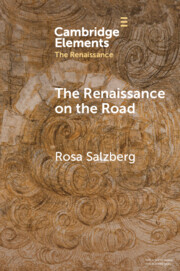Element contents
The Renaissance on the Road
Published online by Cambridge University Press: 19 June 2023
Summary
- Type
- Element
- Information
- Series: Elements in the RenaissanceOnline ISBN: 9781108963886Publisher: Cambridge University PressPrint publication: 13 July 2023
Bibliography
Primary Sources
Secondary Sources
- 10
- Cited by

